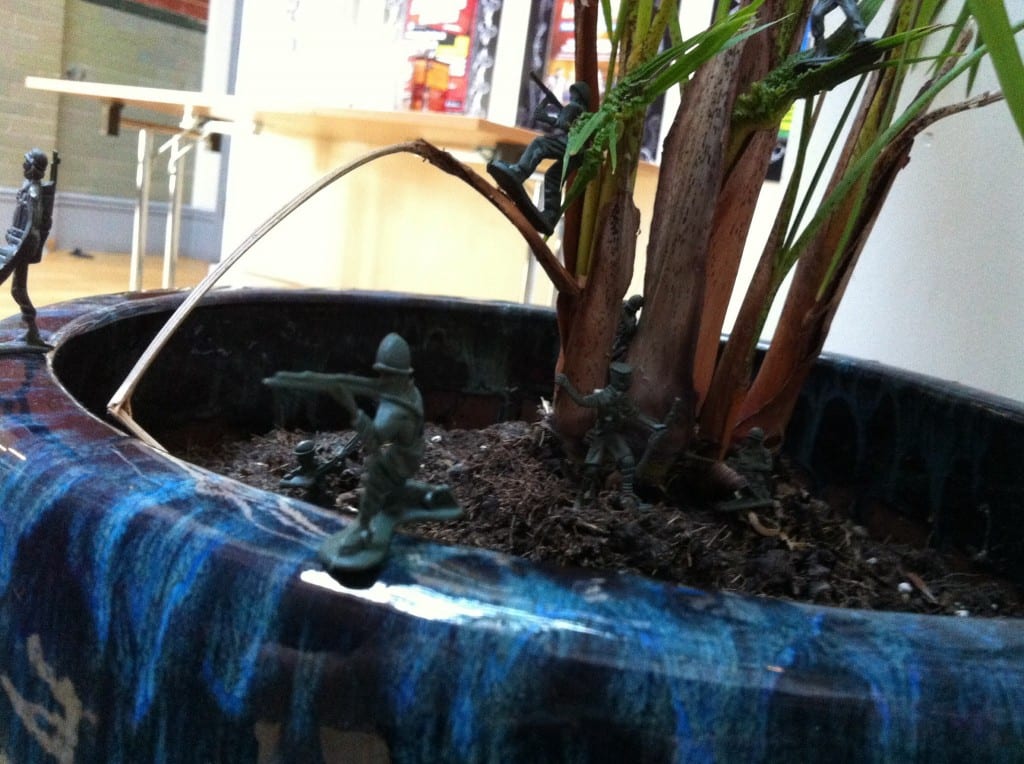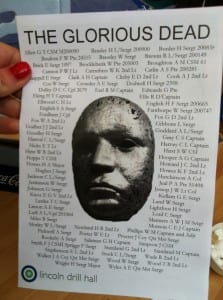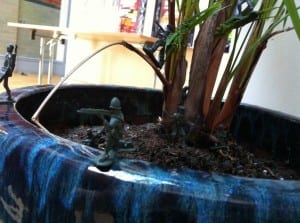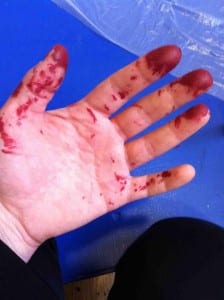Framing Statement
The Glorious Dead was performed at the Drill Hall on the 8th May, 2015 performed by three women. The piece was heavily influenced by the works of Jake and Dinos Chapman and Antony Gormley as well as the Drill Halls history. The performance was a durational piece and through the use of toy soldiers memorialized the eighty five soldiers Lincolnshire Regiment that fought in the 4th Battalion. Our piece was also an exploration into memorial services of today and whether audiences would take the time to pay respect to those that have passed when given the option or if it is something that is forced upon. This we would only discover on the day of our final performance.
We were a production line of three women in our piece and we had three stations. The first station consisted of one of us turning a sand timer and watching the time go by (holding one of the toy soldiers) as though they are waiting for another soldier to pass in order to move onto the next station. The use of the sand timer comes from the fact that the 4th Battalion took place in Egypt. The middle station then had us taking our chosen soldier and within the time limit of one minute we painted them the colour red. This was used to represent their death and the more our piece progressed the more paint ended up on our hands. This was to portray the unsettling reality of the amount of blood that would have been shed during the war. The last station required the member to announce the name of the “lost” soldier and then they gently brought their red toy soldier over to the table and carefully placed them under the plaque in the drill hall cafe that reads, “In memory of The Glorious Dead of the 4th B.N (T.F) Lincolnshire reg”. Then the same person would spend a minute reading the plaque. After each minute we rotated in a circle to each station until all eighty five soldiers were painted red and placed under the plaque. The whole piece lasted eighty five minutes and the piece was to be performed in complete silence in order to give a minute silence to each soldier that had passed, this meant that every action that occurred within the three different stations could only last a minute long until we moved onto the next.
Our audience are members of the public that would have decided to come to the drill hall that day, not necessarily to see our piece but to go about their day as they would have normally, as we did not want to force an audience to watch the durational piece. We wanted the members of the public to be surprised by the piece as it would have disrupted their vision of how their time at the drill hall would have been without us performing. The reason that we chose to not invite anyone to our performance is because we wanted our audience to play a part of our piece. We wanted to question whether audiences of today when given the opportunity would actually choose to watch a memorial service and pay respects, or if memorials are something we feel we are forced to sit through, and do we pretend that we are remembering those that we most likely never knew to begin with? Turner states “This reading stood and stands as a provocation or open invitation, rather than a practical proposal” (Turner, 2010, 156). The piece was created to be an open invitation to those in the Drill Hall café as we allowed our audience to stay for as little or as long as they would like. We also placed ourselves on the stage away from where the audience would be seated and we ensured that the gunshots fired would be loud enough to hear but not too loud to ensure that we did not cause disruption to those who did not want to spectate.
Process
After touring the Drill Hall I found there was one area that stood out to me. Firstly before entering the cellars we needed to travel down some concrete stairs and while doing so I realised that the Drill Hall had a ghostly feel to it. On the way down to the cellar I also found a hole in the middle of the brick wall and imagined how frightening it would be if a person or someone’s hand appeared from it or if someone were to scream whilst I was looking at this area. From this I thought it would be interesting to explore how I could scare my audience during a performance in the Drill Hall as well as telling the Drill Halls history. I shall look into the history of the Drill Hall and how it used to be used as a hospital and I shall research the names of the men that appeared on a plaque in the cafe and see how I could incorporate this into my piece.
On Friday we visited the Drill Hall again and were given tasks to complete in groups. Firstly we needed to create images with our bodies that highlighted ‘unnoticed spaces’. Our group visited the Abbey room and created an image using our bodies to fit a space by the bay window. The image looked interesting and created a nice shadow effect however the space we chose could not be considered totally ‘unnoticed’ as it was one of the first things we saw as we walked into the room. Instead we found a space in the wall and taking inspiration from Willi Dorner’s “Bodies in urban spaces”, we created an image with our bodies in this area. We then needed to create signs and layer this with our movement and then create a five minute performance that used our signs and shapes within it. We decided to create signs that represented how we felt in the shape we created. We then used these signs in our performance by walking through the audience and acted like our chosen words. For example I chose the word “Trust” and so I handed out items of mine to members of the audience as I would have trusted them to return them, just before getting into position. It was interesting to see how an unnoticed space could be turned into an entire performance. We considered this when devising our final piece and looked into all areas of the Drill Hall before we decided where we would perform.
From visiting the Drill Hall again ideas were sparked into how our group could remember those that died during the 4th Battalion and allow our audience the time to remember with us. Initially we decided that we wanted to create a miniature version of the room upstairs and to tell stories of the different soldiers who may have once spent time in that room through the use of audio. We then questioned why? Why would we create this piece? To remember them? We then came to the realisation that it would be impossible to remember those who we never knew to begin with. We then discussed why we go to memorial services and came to the conclusion that it was to pay respects to those that had passed. This was something we wanted to explore and highlight within in our piece and our piece would “serve to illuminate, explicate and problematize the multiplicity of meanings that reasons within and from landscapes” (Pearson, 2011, 2) as our piece would be performed in the drill hall a place where memorials are not taken.
As a group we already knew we wanted to use toys in some way in our performance to show literally the effects that the war had on soldiers.
We researched into and were inspired by the works of Jake and Dinos Chapman and their piece titled “Hell”. Their work through the use of toy soldiers showed “the ravages of contemporary war” (Jones, 2015). This is what we wanted to also portray within our work as we were inspired by the fact that Jake and Dinos showed the “terrifying truth” (Jones, 2015) of war. This confirmed our idea of dehumanising toy soldiers in our performance similar to that of Jake and Dinos as “The manipulation of the material landscape in it’s own right, the artist adding, removing or displacing materials- marking, cutting, rearranging – to create sculpture. drawing out the relationships between existing characteristics of site and evidence of human evidence”(Pearson,2010). We decided that we would paint the soldiers red in to represent the soldier’s death. This would be after we had researched into how many soldiers died during the 4th Battalion in the Lincolnshire regiment.
We did some research into how many lives were lost in the 4th Battalion and found that eighty five had died and this lead us to decide that we should paint eight five toy soldiers red. We agreed that we should do this action in silence and for eighty five minutes so that we would give a minute silence for each soldier that passed allowing our audience to also take the time to question our piece and want to learn more about it, and also to take the time to give silence with us if they so wish. We decided the cafe would be the perfect space to work with as it contrasts with our performance. The Drill Hall cafe is a sanitized area and is decorated in light colours and therefore is inviting and cosy. We are painting toy soldiers a dark shade of red and the three of us have decided that we shall be dressed in what we as individuals would wear to a funeral as we do not want to play characters but ourselves. As a whole this could be considered disturbing for the members of the public that could witness our piece taking place as a “funeral” would juxtapose with the Café. The Drill Hall cafe also has a plaque in the middle of the cafe with some of the names of the soldiers that passed but is shown in a formal and “glorified” way whereas our group want to show the horrific reality similar to what Jake and Dinos achieved with their artwork.
We researched into Forced Entertainments performance “Nights in the city” which consists of an audience being taken on a tour of Sheffield. The tour guides throughout the piece create lies about the area that the audience are seeing. “for example, the audience was told: all of the streets round here got names after famous football hooligans from history and all buildings got names from ghosts and cleaning products and convicted kerb crawlers”. (Kaye, 2000, 7) Nights in the city is a site specific performance because if they were to perform the piece in any other area the history would not be the same as Sheffield and therefore the piece would need to be completely different. Etchell’s emphasises this as he questioned “How long do you have to have lived somewhere before you can lie about it?” (Govan et al, 2007, 131). Although the piece itself did not inspire our piece this quote from Forced Entertainment’s Tim Etchells made us question whether history is entirely true. We then did further research into the 4th Battalion as we wanted to find stories about the soldiers, in order to tell the audience stories about them hoping to make the inanimate objects feel more “real” to the audience and to tell a narrative. From our research we only were able to find two obituaries and two photographs. That still left eighty one soldiers lives left to be unknown to many other than their names. This made brought back our thoughts about how we could “remember” those that we did not know to begin with. Perhaps our piece was not to remember the soldiers but to pay respect to them and to show the facts to the audience. Eighty five soldiers lives were lost.
Expanding on this we thought deeper into how we could show the truth to our audience. We decided we would create a booklet in the same style as the programmes that sit in the drill hall. These booklets would have the soldiers names on the front cover and on the inside have the two obituaries and the two photographs that we could find. We also created a “menu” of all of the soldiers names numbered from one to eighty five. This was so that the audience could make the connection between the toy soldier and the real soldier, as we had a “count up” on a screen counting from one up to eighty five. We hope that our audience would be able to see that the soldiers we have painted are the number of soldiers that have died and are the number would be also shown on a screen. Ideally the audience would be able to see on their menu a number and a soldiers name next to it, and would be able to understand that the soldier on the menu represented the soldier that had just been painted. This would be made clearer by the fact that we would have called the soldiers name once we had finished painting them each minute, before placing them under the plaque.
From further research into site specific art work we found that we were inspired by Antony Gormley’s “Field”. This is because he used a large number of clay models to “completely occupy the space” (Gormley, 2015) making much more of an impact. From this we decided that as well as our eighty five soldiers we would also fill the drill hall with as many toy soldiers as we could to make our audience feel that they are surrounded by toy soldiers. We would also fill the stage with toy soldiers facing the audience so that the audience would feel that the toys are directly watching them watching our performance. We practiced setting up the toy soldiers as shown in this video. https://www.youtube.com/watch?v=O9yTmCeD3no (Cherie Jones, 2015) “As a viewer, you become aware that you have unwittingly walked onto a stage where the normal relationships between observer and observed were reserved and it was the art that looked back at you”. (Gormley, Leader, Orbach, Salecl, 2008, 360.) From viewing Gormley’s work we wanted our audience to feel disturbed by the vast majority of toy soldiers in order to provoke the audience to consider to watch our piece and to want to find out more about it. This is why we chose to have a vast amount of soldiers spread throughout the cafe and in the audience’s personal space, such as in the sugar pot so that the audience felt surrounded by them. This way the audience will feel emotion due to the manipulation of the soldiers giving them a very small insight to how much of an impact losing the real eighty five soldiers would have been for those around at the time.
Performance Evaluation
Our final piece challenged us mentally and physically but enabled us to gain a deeper understanding and appreciation for performance art and made me realise a performance does not always mean “to perform a performance of a given duration on a given theme for a given number of spectators” (Pearson, 2010, 190). In preparation we began setting out some of the soldiers around the Drill Hall and even found that we could fit them in part of the brick walls which were intriguing to look at as the toy soldiers were placed higher up than the audience making the audience potentially feel more surrounded, and physically connecting the soldiers with the building. We then set out the rest of the seven hundred toy soldiers around the drill hall and on the stage where we would be painting them. This took us about an hour long meaning that at three we were ready to begin our “production line”. The ‘production line’ was an innovative idea created by Henry Ford, who then used it in order to create cars at a much faster rate. The fact that our production line consisted of three women gave a different impact to if the same performance were to have occurred by three men. The eighty five minutes of waiting, painting and “mourning” seemed to pass by a lot quicker than we thought it initially would as we thought being in silence would make time feel a lot slower.
During our piece there was an over riding sense of guilt for different reasons. I felt guilt as I was painting the soldier, as the facial expressions and detail on the soldier were being painted over signifying their death. I feel I should have felt guilty due to the fact that I was symbolising the death of this soldier, but for me personally I felt worse knowing that once I had placed the soldier under the plaque the soldier would be left to still be forgotten by many, especially when considering what these men gave up to help our country. This emphasised the ideology of our piece as we wanted to question why we mourn to begin with. I did not know the men yet I still felt as though I were mourning for their deaths. Our audience changed many times within the eighty five minutes as most would watch for a couple of minutes and once the realisation that we were repeating the same three actions hit them, they would leave. Most of those who came to watch also did not take the time to read the booklet in front of them to find out further about the soldiers. The audience were a part of our performance as they further proved that most when given the option to sit through a memorial or not would only give up a little of their time.
Our piece had reasoning behind everything that was embedded into our piece so it is hard to tell what I would have changed if I had the opportunity to start over. After performing The Glorious Dead I have gained much respect for site specific performance as I realise a lot of research and thought is required in order for a piece to be a success.
Word count: 3045
Bibliography:
Cherie Jones (2015) Site Specific The Glorious Dead. [online video] Available from https://www.youtube.com/watch?v=O9yTmCeD3no [Accessed 5 May 2015] .
Gormley, A (2015) FIELD. [online] Available from:
http://www.antonygormley.com/projects/item-view/id/245
Gormley, A. Leader, D. Orbach S, and Salecl, P. (2008) Public space and the body, 24 (1)
360.
Govan, E. Nicholson, H. and Normington, K.(2007) Making a Performance Devising Histories and contemporary Practises. Oxon: Routledge.
Jones, J. (2013) Why the art of war is hell. [online] theguardian. Available from: http://www.theguardian.com/artanddesign/jonathanjonesblog/2013/jul/25/imperial-war-museum-contemporary-war-art [Accessed 5 May 2015].
Kaye, N. (2000) Site-Specific art performance, place and documentation. London: Routledge.
Pearson, M. (2010) Site Specific Performance. Basingstoke: Palgrave Macmillan
Pearson, M. (2011) Why Performance? [pdf] Available at: <http://www.landscape.ac.uk/landscape/impactfellowship/peforminggeographieswarplands/toolkit.aspx> [Accessed 5 May 2015].
Turner, C. (2010) Dramaturgies of Public Space. Contemporary Theatre Review, 20 (2) 156.






